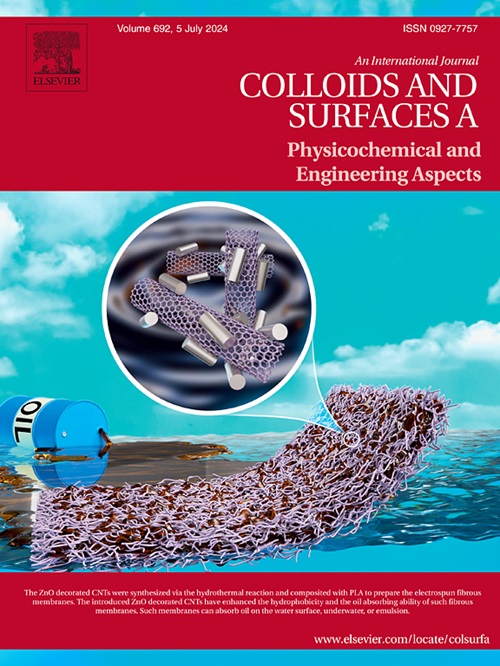Multi-layered quasi-2D perovskite based triboelectric nanogenerator
IF 4.9
2区 化学
Q2 CHEMISTRY, PHYSICAL
Colloids and Surfaces A: Physicochemical and Engineering Aspects
Pub Date : 2024-11-06
DOI:10.1016/j.colsurfa.2024.135728
引用次数: 0
Abstract
Inorganic-organic perovskites are considered as one of the emerging candidates as a tribopositive material in triboelectric nanogenerators (TENG) owing to their unique functionalities. Among them, quasi-two-dimensional (quasi-2D) perovskites are promising materials for TENG due to layered nature, excellent environmental and chemical stability, tunability, and excellent electrical properties. Herein, we investigate the performance of TENG based on multiple series of perovskite layers using simple solution processing technique. The dimensionality of the perovskite layers is attained by changing the stoichiometric ratios of phenylethylammonium iodide (PEAI), lead iodide (PbI2), methylammonium iodide (MAI). The quasi-2D based TENG generates the maximum output electrical performance with a voltage of 306 V, current of 4.71 µA, and maximum power density of 3.48 µW/cm2 at the optimum value of (<n> = 5) due to the higher concentration of C–N and N–H groups. Moreover, the fabricated device shows stable performance for 12,000 cycles. The TENG device is further utilized to charge the various commercially available capacitors, for lightning of light-emitting diodes (LEDs), and to power up low-power electronic devices. These results demonstrate the effect of the dimensionality of perovskites on the output performance of the TENG for use in next-generation energy harnessing.
基于多层准二维包晶的三电纳米发电机
无机有机包晶石因其独特的功能而被认为是三电纳米发电机(TENG)中新兴的三电材料之一。其中,准二维(quasi-2D)包晶石因其层状性质、优异的环境和化学稳定性、可调性和出色的电学特性而成为很有前景的三电纳米发电机材料。在此,我们利用简单的溶液处理技术研究了基于多系列包晶层的 TENG 性能。我们通过改变苯基乙基碘化铵(PEAI)、碘化铅(PbI2)和甲基碘化铵(MAI)的化学计量比来实现包晶石层的维度。由于 C-N 和 N-H 基团的浓度较高,基于准二维的 TENG 在最佳值(<n> = 5)时可产生最大输出电气性能,电压为 306 V,电流为 4.71 µA,最大功率密度为 3.48 µW/cm2。此外,所制造的器件在 12,000 次循环中表现出稳定的性能。TENG 器件还可进一步用于为各种市售电容器充电、为发光二极管(LED)照明以及为低功耗电子设备供电。这些结果表明了包晶尺寸对 TENG 输出性能的影响,可用于下一代能源利用。
本文章由计算机程序翻译,如有差异,请以英文原文为准。
求助全文
约1分钟内获得全文
求助全文
来源期刊
CiteScore
8.70
自引率
9.60%
发文量
2421
审稿时长
56 days
期刊介绍:
Colloids and Surfaces A: Physicochemical and Engineering Aspects is an international journal devoted to the science underlying applications of colloids and interfacial phenomena.
The journal aims at publishing high quality research papers featuring new materials or new insights into the role of colloid and interface science in (for example) food, energy, minerals processing, pharmaceuticals or the environment.

 求助内容:
求助内容: 应助结果提醒方式:
应助结果提醒方式:


